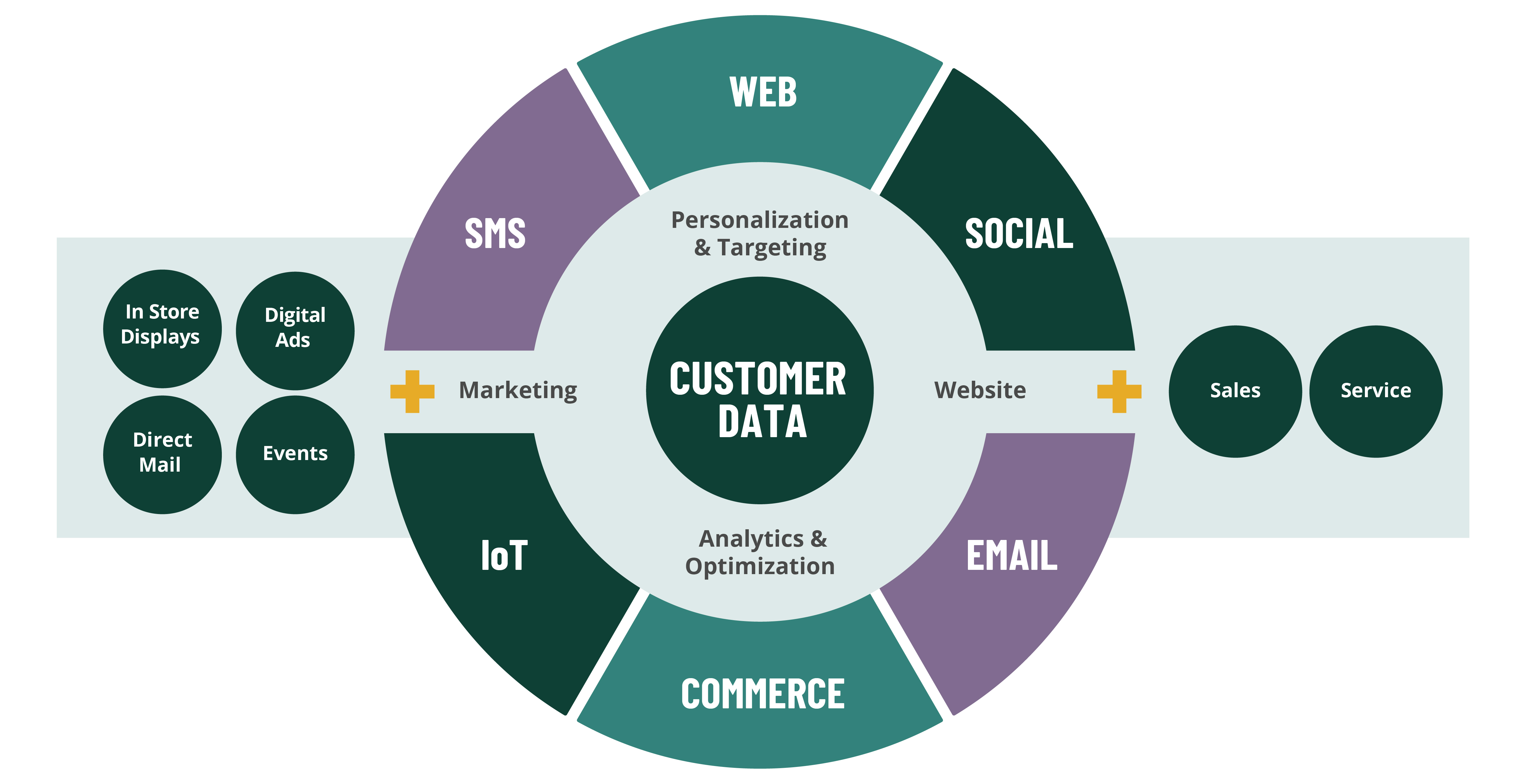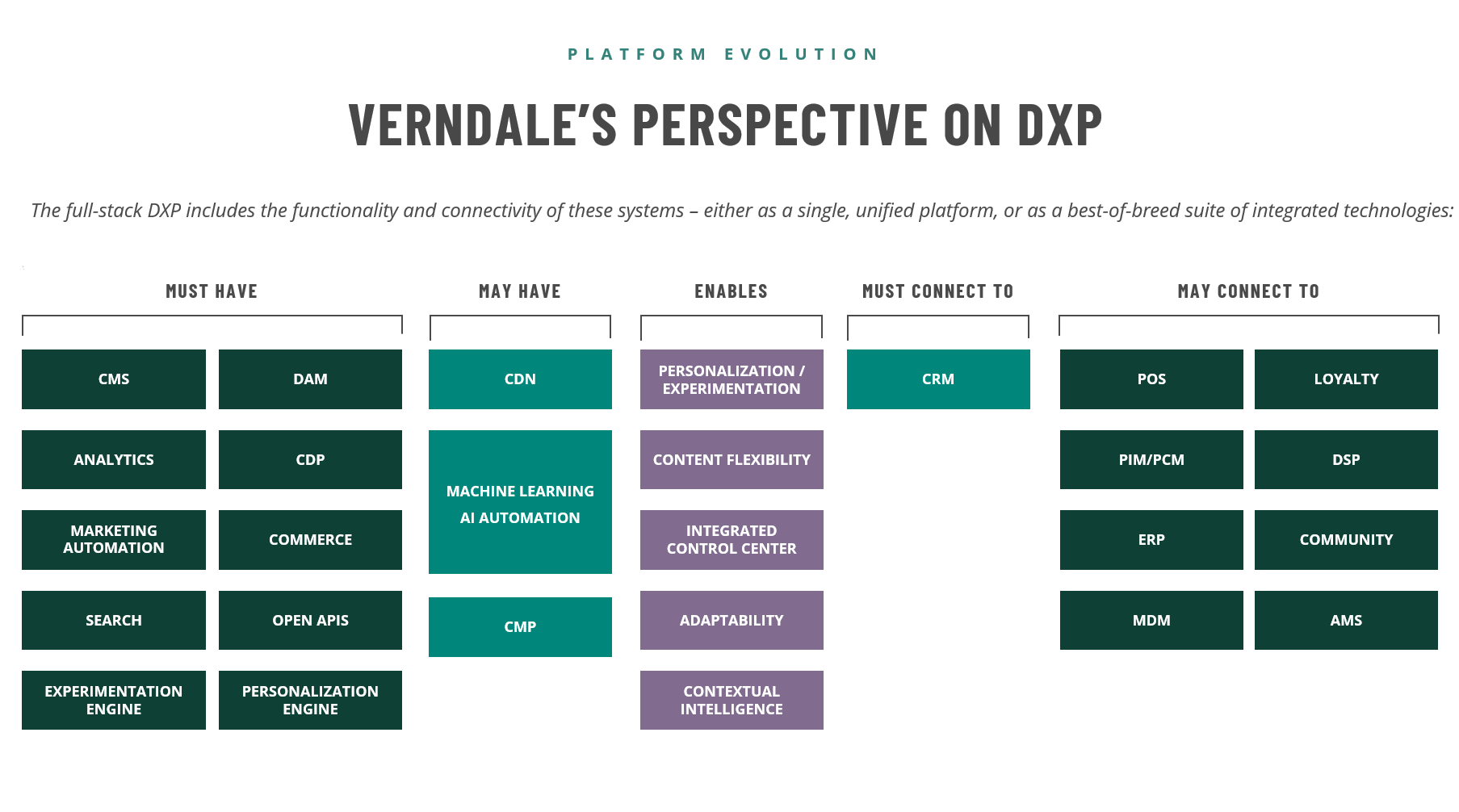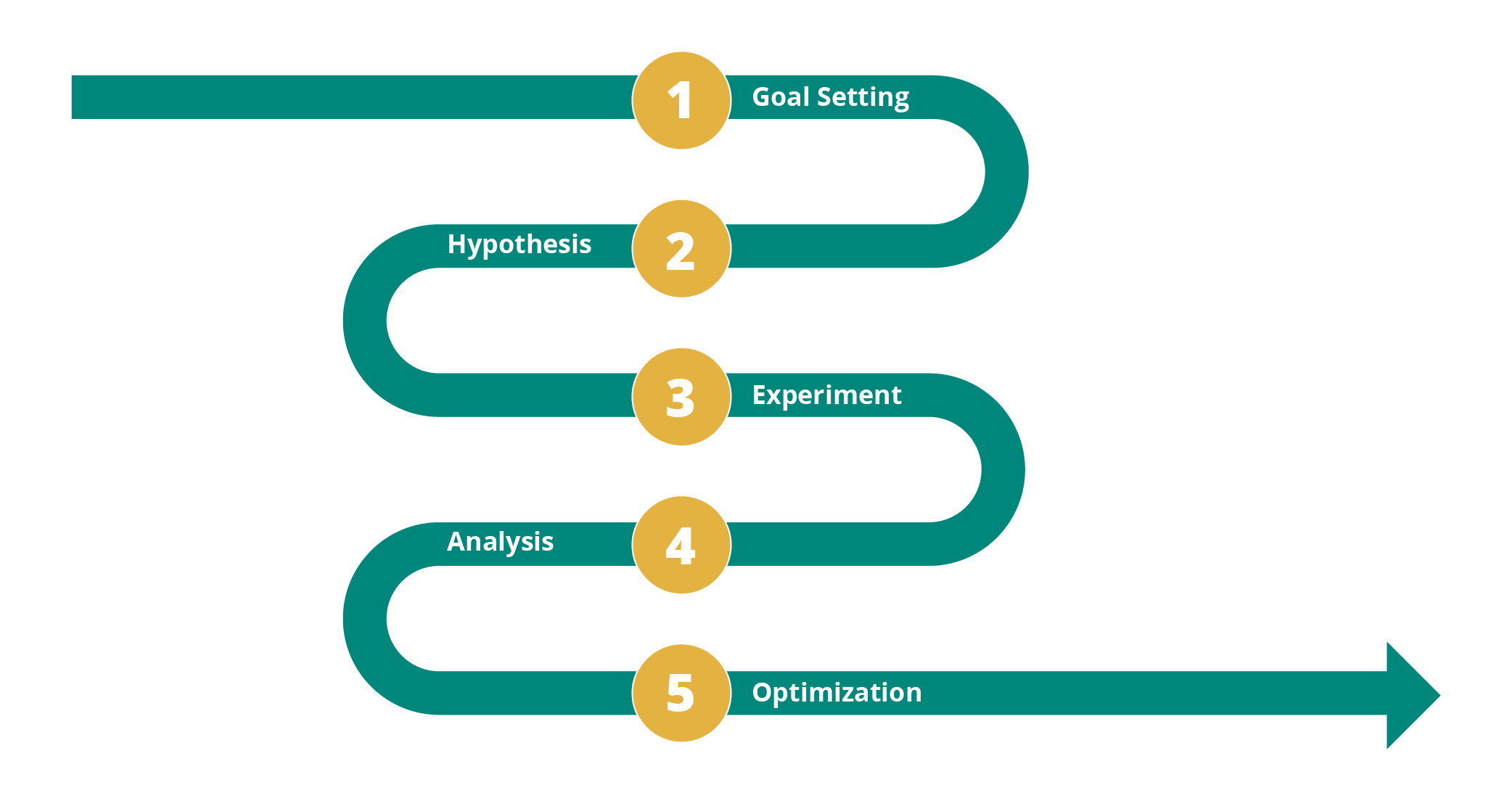Your CX Quarterback: The Customer Data Platform (CDP)
Oct 28, 2021 • 7 Minute Read • Elizabeth Spranzani, Directrice de la technologie


The composition of the digital landscape is changing quickly, accelerated even more so by the Covid-19 pandemic. Acquisitions by major Digital Experience Platform (DXP) players flooded our inboxes last year announcing Content Hub, Insite Commerce, Idio, Boxever, Optimizely, Four51, Moosend, Reflektion, and many more. And with industry acronyms like CDP, CMP, DAM, PCM, MA, MRM, and DXP, there are too many to count. The differences between these platforms and others such as CRM, DMP, and PIM can be nuanced but important to understand.
A few years ago, Sitecore and Optimizely (Episerver) were considered just Content Management System (CMS) platforms, but have now evolved into DXPs.
Important questions come to mind around navigating the landscape: Should my system of record for customer data be my ERP, my CDP, or my CRM? Will what I have now suffice for my product data needs, or do I need a more robust Product Information Management (PIM) platform? Why are these platforms calling themselves DXP now, instead of CMS? What do I really need?
Also, there is understandably some confusion about the features and functionality that are introduced (or reintroduced) with these acquisitions: Didn't the core platform already have that functionality? Do I want to keep using the features in the core platform, or switch over to the new SaaS platform?
Businesses need to be focused right now on their operations and surviving the current wave of evolution, not wading through countless articles and definitions. They need help making decisions.
At Verndale, we sat down to get organized around DXPs and their anatomy, to help the rest of our organization understand what platforms play what roles and what they mean to our customers. Here we'll discuss the types of platforms that the perfect DXP aspires to have, what key functionality it should enable, and what other systems are interconnected.
A DXP is an open and extensible, integrated suite of cloud-based technologies that provides all audiences with consistent, secure, and personalized experiences across digital touchpoints. When did your CMS become a DXP? The answer is when it stopped being just about content and started to also address customer data, personalization/experimentation, assets, and analytics. Think of a CMS now as only one part of the DXP platform focused on delivering content. Its origins were focused on a single channel, the website, and typically it was a single system. For many of the CMS platforms, headless and API technologies were addressed much later.
As the platforms evolved into DXP, the definition now typically includes a wide span of channel touchpoints. Content isn't the only focus, and there are suites of integrated cloud-based headless platforms coupled together via API endpoints: a more composable architecture now makes sense.
In a monolithic architecture, all the features and functionality are combined tightly together into one system, making it slow and complex to roll out updates and upgrades. With a composable architecture, each component is loosely coupled and focused on what it's great at, meant to be pluggable, scalable, replaceable, and continuously improved and evolved.

The core principles of a DXP today are:
The DXP has platforms that are widely recognized as core to DXP and others that are optional. After really thinking it over, our team came to the following consensus, these platform types could be in the suite within a single platform, or as a best-of-breed suite of integrated technologies.
Obviously, there are a lot of potential MarTech platforms and so a DXP must make it easy to integrate with those, whether it's a third-party or the same DXP vendor.

But what drove our decision to put these particular platforms into the "Must Have" column? We believe that as omnichannel delivery becomes more of a baseline for businesses, there is a very real need to have platforms that can manage content and media in a single place (CMS and DAM), which is then leveraged in experimentation and personalization platforms to meet the expectations customers now have that your business knows who they are and can give them exactly what they want. The only way for you to keep up with this is to leverage CDP and Marketing Automation platforms, which will give you the full view of that customer, machine learning-driven insights, and tell you how to market to them. This will save you a lot of time and give you the ability to activate previously siloed data in a way you never could have before. If your business is also selling them something, then a Commerce platform must also be available.
Let's dive a bit deeper into these core systems.
A CMS powers an organization's website/applications with tools needed to deliver content - including editorial, workflow, reporting, organization, security, and user administration. A competitive CMS must include features that enable multi-site, multilingual, publishing and preview modes, workflow, media library (and/or integration to DAM), and at least basic search indexing. The best CMS platforms will have a way to offer page orchestration via the visual display with WYSIWYG editors, and integration with a personalization and experimentation engine for delivering 1-1 content experiences to end users.
With the advent of machine learning, CMS platforms can provide smarter and more personalized content recommendations.
The CMS is the primary source of your content for all of your channels, and likely the home of your website. It's where you will define your webpages, including meta data and page URLs, in addition to the content.
Some of the best DXP platforms will bundle their CMS with a SaaS Search platform. The CMS itself will have basic search capabilities, usually through its API, and usually with some kind of indexing mechanism. However, building out custom search functionality for facet filtering, predictive/suggestive search, results that leverage boosting, sorting, multi-word search phrases, special characters, multilingual, misspelling forgiveness, plural vs singular, thesaurus, stemming, etc can be very time-intensive and expensive to build.
There are SaaS search platforms that can be paired with a CMS that will enable all of the above with out-of-the-box configurations plus much more. Now, these platforms will use analytics and machine learning to teach its search algorithms to be smarter about understanding what users are actually searching for based on others' behaviors and natural language processing. Important insights are surfaced around what people are searching for and whether the content needs to be created to fulfill what isn't being found. It can power automatic landing pages, adaptive navigation, and guided search. Content can be re-ranked in real-time. These search platforms may also provide federated search (searchable content across multiple platforms and sources). Typically access directly to the indexed documents will be made available via a UI in the search administrator tools.
The cost of reinventing the wheel for building out the features and functionality that one of these platforms provides out-of-the-box may outweigh years of the licensing cost. And likely what you get won't come near the quality of the output of the results, especially factoring in the machine learning and insights that it provides. As DXP platforms partner with and/or acquire a SaaS search platform into their ecosystem, you may not have to pay any major extra costs to use it.
To really dive into CDP, you can read more about it here and why we believe it's one of the most important systems for a business to invest in now - YOUR CX QUARTERBACK: THE CUSTOMER DATA PLATFORM (CDP). In summary, CDP is a collection of software that creates a persistent, unified customer database that is accessible to other systems. Data is pulled from multiple sources, cleaned and combined to create a single customer profile. This structured data is then made available to other marketing systems and marketers to create targeted and personalized marketing campaigns.
Unlike data warehouses and data lakes, CDPs process the raw data to make it more usable and apply identity resolution. They’re designed to drive customer interactions in addition to supporting analysis and are purposefully built to meet a marketer's needs. CDP should not be confused with a Customer Relationship Management (CRM) system, which is designed for sales (not marketing) and does not typically aggregate or analyze data from multiple sources.
CDP is quickly becoming one of the core sources of data for activation in Experimentation, Decisioning, and Personalization.
A CDP brings your customer data together in a single place where you can get a full picture of who they are, so that you can know what to do next with them. The CDP will use machine learning to get you to those insights faster and more comprehensively, and then share that knowledge back out to the various platforms where you can now act on it. It's the brain of the DXP YOUR CX QUARTERBACK: THE CUSTOMER DATA PLATFORM (CDP).
At Verndale, experimentation is both a practice and an ethos. We believe innovation is a constant, and evolution is iterative. Our digital marketing, experience design, and technology teams leverage a test-and-learn methodology in every phase of every engagement.

A test isn't an experiment, and an experiment isn't a test. Experimentation is done without fear of failure or expectation of outcome. Testing is done with an expectation of a winner. Experimentation leads to new things, while testing validates assumptions. We will leverage tests within experiments, such as A/B, multivariate, and multi-arm bandit.
Experimentation platforms provide capabilities to run tests that prove hypotheses within experiments. Tests can be created to run both within websites and also in third-party systems (full stack experiments). These platforms typically make it very easy for marketers to execute simpler tests for a website, directly within the platform, creating variations of components and rolling them out in experiments to different audience segments, without the need for a developer. They leverage robust algorithms and statistics to determine winning variants, and all of the true competitors in this space will have excellent and easy-to-understand reporting and visualizations of results and metrics to allow you to act appropriately on the findings. To start using an experimentation platform can be as simple as adding a Javascript snippet to a website.
Personalization enables you to deliver targeted, relevant content to your visitors, based on demographic, behavioral, and transactional data. This goes hand-in-hand with Experimentation and the same platform should be able to do both.
Decisioning is part of Personalization and the reason it's called out separately is that some of these platforms have very robust decisioning capabilities. It's far more than just "if the customer meets x rule, then show y". Decision automation workflows can be built out by taking in data from multiple channels, programming in complex criteria, applying AI models, and leading to multiple variants and results.
Customers absolutely expect personalized experiences now. It's the new customer experience (CX) standard. They want to engage with brands that understand them and their needs. If you aren't actively personalizing your content now, then your competitors will have a leg up on you.
A DAM platform is a single source of truth for a business's marketing assets and distribution and is a centralized repository that allows organizations to store, organize, find, retrieve, and share digital files. With a DAM, you can efficiently manage, store, and search for almost any asset including photos, layouts, artwork, video, 3D, source files, and more, and set complex metadata on your files. Its scope is meant to cover all aspects of the organization, the website being only one segment of that. Print, mobile applications, and other media need to be considered as well. The DAM allows you to deliver a unified digital asset experience across all of your marketing and sales channels. Files can be served directly from the DAM, and some also function as a Content Delivery Network (CDN), guaranteeing high uptime and better performance/delivery by being redundantly stored across regions to accelerate delivery to end users. Most DAMs have full Digital Rights Management (DRM) complete with rights profiles, contracts, and sophisticated rules to manage assets at scale.
Historically, we often saw our more enterprise-level organizations use a DAM instead of their CMS's Media Library. Web Content Media Library only serves the spaces covered by web content management. But now, due to the increased adoption of other digital channels, we are seeing it make sense for all organizations regardless of size.
Your business is already omnichannel, or has roadmaps to get there. It isn't practical to manage media in multiple places. The same single image stored in a single location should serve your website, mobile app, email marketing message, kiosk, syndicated product feed, and social media page.
MA platforms handle automated, repetitive marketing tasks such as sending out mass email marketing campaigns, scheduling social marketing posts, or updating marketing campaign data. They’re also used for segmentation, lead targeting, and lead scoring. Primary addressable channels include Email and SMS, as well as potentially website landing pages. Automated workflows to handle various situations for new users, cart abandonment and completing a purchase should be available. Other features include analytics and tracking on campaign success, as well as transactional emails such as reset password and order confirmation. The platform makes it easier for marketers to create email templates that are visually appealing, with drag and drop functionality and personalization of content and media that can be pulled in from other systems such as DAM and CMS/CMP.
This is one of the primary channels on which the CDP will enable activation. It isn't just about what you are delivering to your customers when they come to you, visiting your website or business, but how you reach out to them proactively. The various workflows will do most of the heavy lifting for you.
This one is probably pretty self-explanatory. If you need a commerce platform, then you probably already have experience with this. However, a commerce platform typically sits between a business' back-end Enterprise Resource Planning (ERP) system and applications that deliver digital storefronts to customers. The commerce platform may or may not include the actual administration tools and storefront application itself. Some commerce platforms focus on Business-to-Business (B2B), others Business-to-Consumer (B2C), and some claim to do both well. Baseline commerce platform features include management of Product Catalog, Cart, Orders, Users, Inventory, Pricing, Promotions, Tax, Shipping, Payments, lightweight CMS, ERP/OMS/PIM integrations, and Globalization. They will often enable customer impersonation, punchout, tiered approval rules, price breaks and custom pricing rules, quotes/CPQ, RMA process, anonymous/authenticated shopping, etc.
With the advent of machine-learning, commerce platforms can provide smarter and more personalized product recommendations.
If you're going to transact and sell something to your customers online in any way, then you need some kind of commerce platform. Because of how much functionality and features come with commerce platforms now, building out your own custom commerce system isn't really practical. Many are highly customizable if that's your need.
This type of platform didn't make it into our 'Must Have' bucket, but it's a really intriguing platform to fill a growing need for reuse and personalized content, and the challenge with keeping that process organized. CMPs allow marketers to plan, schedule, and organize content production within a structured, streamlined process. You can drive greater efficiency through stage-gate workflows and dashboards, and steer teams to achieve key targets with intuitive collaboration, review and approval tools. The content can then be distributed to multiple channels.
It's the answer to your content crisis, your tactical and organizational hub for managing your content initiatives. It can tell you what content you need to have created by whom and by when, to deliver on all of the planned experiences and campaigns.
If you have Commerce, then you are likely already familiar with PIM platforms. A PIM is a single source of truth for product data including attributes, specifications, brand content, image/video and file references (often referencing the master source in a DAM). Products can be organized into different catalogs and categorized with data taxonomies. A PCM platform, often thought of as PIM-light, also does all of this.
But additionally, and most importantly, a PIM goes farther than data enrichment. There are three components of a PIM that a PCM may not have at all, or may not do well.
Other key systems that can be closely entwined with the DXP ecosystem are defined here:
Now that we have reviewed the DXP anatomy, you probably see there is some overlap across platforms with certain feature sets and functionality. A CDP and Commerce platform may both offer product recommendations. Both Marketing Automation and CDP could deliver on email campaigns. The Marketing Automation, CDP, and Search platforms may segment audiences. And basically, everything in the suite includes some form of personalization. Part of this is due to the fact that some platforms developed separately and now are being used together. When they were on their own, it made sense to try to do more. But now there might be a better option.
A great example of that is with the core CMS platforms for Sitecore and Optimizely. Both have built-in functionality for experimentation, personalization, and customer data. But now Sitecore CDP/Personalize, which came from the Boxever acquisition, is a far superior option than Sitecore XP, and Optimizely ODP/Experimentation is replacing Episerver Visitor Intelligence and Profile Store.
As you begin to evaluate the particular offerings in each category from different DXP platforms, you'll see some are more comprehensive and others are more composable, meaning they play better with being plugged into different platforms. That is, in fact, the goal of the composable/agile DXP architecture - having the freedom to pay for only the systems you need and being able to pick the best ones for your business. Maybe you stay in the suite, maybe you don't.
Now you may understand the DXP much better, but it's still a tall order to know how to evaluate what your business needs across and within DXPs. That's why Verndale is here for you. As platinum partners to some of the best DXP offerings, we know their strengths and weaknesses, where the overlap occurs, and in what situations which products and services to choose. Let us put our expertise to good use and help guide you through your decision-making processes. Contact Us to learn more.
This article was originally published on August 10, 2021 and was updated.
